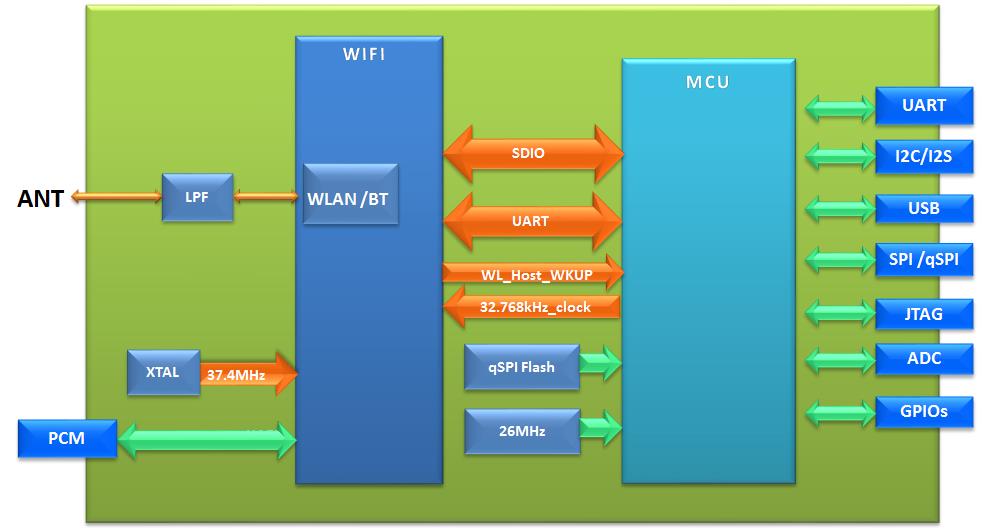- Media Highlights
- 07/06/2017
New Industrial Trends of USI Smart Home Service Expansion (I)
USI Internet of Things Module Block Diagram
(Nantou) Since the Internet of Things (IoT) was first proposed by the International Telecommunication Union (ITU) in its 2005 report, "The Internet of Things", IoT has always been hotly sought after. With the popularization of cloud services, people can communicate with one another and obtain information via the Internet, and things can also exchange information via the Internet. USI is a pioneer in the field of the Internet of Things. In recent years, USI's WiFi SiP modules have gradually been integrated into home appliances and commercial electronic devices.
USI IoT Modules and Blocks
Take home appliances as an example. In the past, when the wireless network was not so common, TVs, air conditioners, refrigerators, or coffee machines at home generally had no interface to achieve data storage via WiFi. Nowadays, almost every household has a WiFi access point (AP) as an extension of the ethernet. This also gives rise to the need for the so-called IoT module, which can work to convert information that needs to be stored by traditional home appliances, including temperatures and on/off states of appliances or electric doors, to WiFi signals via their own WLAN chips. With a 2.4Ghz or 5Ghz antenna, you can access the cloud server through the WiFi AP in your home to upload and download data for purposes of data management, remote control or remote debugging.
To facilitate connection with home appliances, a developer's product normally includes a low-power MCU. Figure 1 is a typical block diagram of the product. The WiFi SiP module uses the MCU (Micro Control Unit) as the core and connects to the WLAN chip through the SDIO interface, and then extends the I/O interface of the MCU to the pin of the entire WiFi SiP module. USI has rich experience in working with home appliance manufacturers. Given the limited amount of data, most applications are done via core connections to home appliances through UART interfaces. SPI/qSPI is used to expand the interface of the flash memory to store larger software codes when it comes to actual applications. Currently, the most common is the combination of the 8Mbit or 16Mbit Nor Flash. In addition, I2C can be used to connect sensors, or authentication chips that must be used on Homekit. Finally, GPIO is used simply for on/off, or even as special interfaces required by home appliance manufacturers through software programs. For example, I2S (IIS) or PWM (Pulse-Width Modulation) signals are used to control peripheral components.
Trends and Product Applications
In terms of the major trends of the electronics industry, the MCU is increasing faster, the SRAM and Flash Memory are getting bigger, and wireless networks are growing faster to meet the needs for more diversified applications. For example, IP Camera needs to support 802.11ac or even MIMO (Multi Input Multi Output) wireless technologies. In the meanwhile, CPU must have high clock and large SRAM for image processing to ensure instant transmission of clear images captured by the camera to the cloud server for users to access. Another trend is energy-saving, power-saving and low-data applications, especially battery-dependent products. However, such products do not rely on high-end hardware, and employ low-power MCUs and energy-saving circuit solutions instead. Take USI's product WM-N-BM-14 as an example. In the "deep sleep" mode, the power consumed can be as low as 0.264mW. In other words, when a 2000mA/h battery is used as the power source, the product in the standby mode can last for up to 10 months.
About USI
USI is a global ODM/EMS leading company providing design, miniaturization, material sourcing, manufacturing, logistics, and after services of electronic devices/modules for brand owners. USI is a member of ASE Group and has been listed in Shanghai Stock Exchange in 2012. It has many years of experience in the electronics manufacturing services industry and leverages the industry-leading technology of ASE Group, which enables USI to offer customer diversify product in the sectors of wireless communication, computer and storage, consumer, industrial, and automotive electronics worldwide. Through the sales service network in North America, Europe, Japan, China, Taiwan, and manufacturing sites in China, Taiwan and Mexico. USI has about 15,000 people worldwide. For more information, please visit www.usiglobal.com



